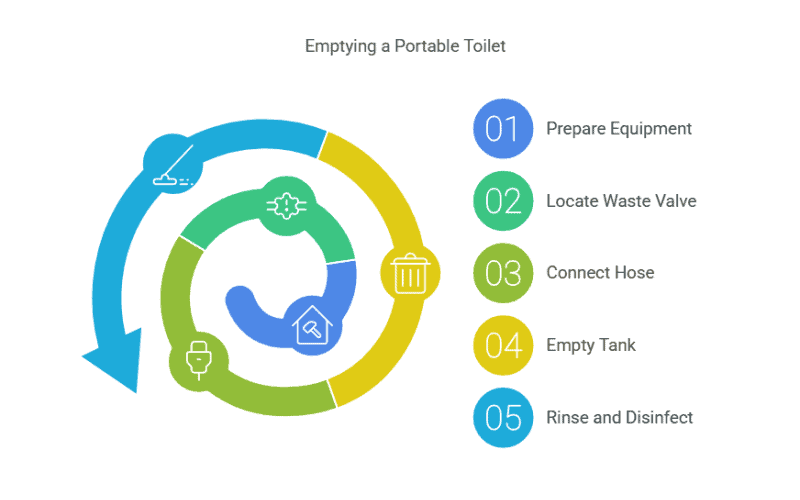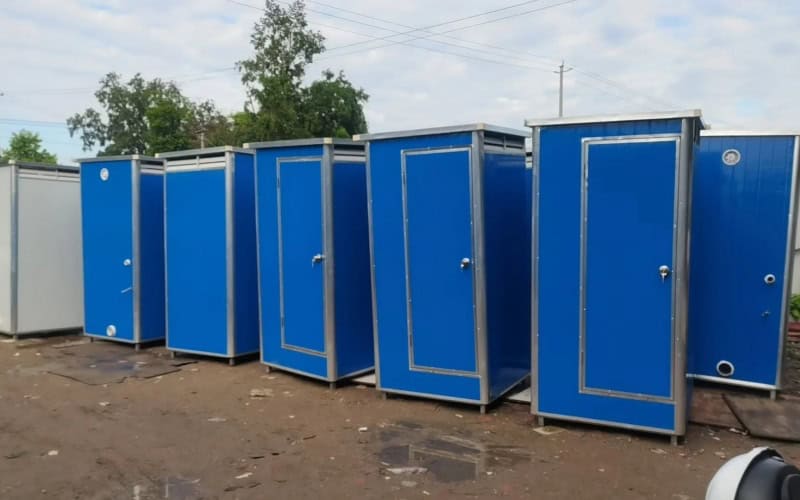Portable toilets are one of those modern conveniences we often take for granted—whether at a construction site, a music festival, or even out in the wild on a camping trip. But have you ever stopped to think about what happens after you’re done using one? How do they stay clean, functional, and odor-free?
In this article, we’re taking you behind the scenes of portable toilets—exploring how they work, where and how they’re emptied, and the best ways to keep them spotless. Plus, as a leading manufacturer of portable structures, we’ve got some insider tips and innovations to share with you. Trust us, it’s more interesting than you might think!
How Do Portable Toilets Work
Portable toilets might seem simple, but their design is a clever combination of practicality, engineering, and thoughtful design. Understanding their functionality is key to appreciating just how efficient and convenient they are.
The Basics of Operation
Portable toilets are self-contained units, meaning waste doesn’t get flushed into a sewer system like in a regular bathroom. Instead, everything is collected in a sealed waste tank beneath the toilet. Many units use special chemicals to break down waste, reduce odors, and prevent bacteria buildup.
If the toilet has a flushing mechanism, it typically works with a hand pump or foot pedal, pulling a small amount of water or chemical solution from a built-in reservoir to rinse the bowl. Meanwhile, the ventilation system helps control airflow, reducing unpleasant smells and keeping the interior fresh.
Because they don’t rely on plumbing, portable toilets can be placed almost anywhere—whether at a festival, construction site, or remote location. Regular servicing ensures the waste is safely removed, keeping the unit clean and ready for use.
Are Portable Toilets Built to Last?
When it comes to portable toilets, durability isn’t just a bonus—it’s a must. High-quality, corrosion-resistant materials ensure these units can handle heavy use and tough environments without breaking down. A properly constructed portable toilet isn’t just about ease of use; it’s about dependability. After all, nobody wants to face a unit that malfunctions at a crucial moment!
Where to Empty Portable Toilets
Emptying a portable toilet isn’t as straightforward as simply dumping waste anywhere. Designated disposal sites and approved methods are established to maintain safety and meet environmental regulations.
Designated Disposal Sites
Portable toilets are typically emptied at waste treatment facilities, septic stations, or RV dump stations. These sites are built to handle human waste safely, preventing contamination and protecting the environment.
- For large-scale events or construction sites, professional waste management companies use vacuum trucks to pump out waste and transport it to treatment plants.
- For RV users, most campgrounds and RV parks have dedicated dump stations. Simply connect the black water tank to the disposal pipe, open the valve, and let gravity do the work.
- For cassette-style portable toilets, the waste tank can be removed and emptied manually at designated public disposal points, such as highway rest areas or restroom facilities. Many locations also provide flushing stations to rinse out the tank afterward.
The best option for most users is a licensed waste disposal facility or a dedicated RV dump station, as these sites are specifically designed to handle waste safely and efficiently. RV dump stations are commonly found at campgrounds, highway rest stops, and fuel stations catering to travelers. To locate one nearby, use RV travel apps, online maps, or check with local park authorities.
Why Proper Disposal Matters
Emptying a portable toilet isn’t just about finding the nearest spot and calling it a day—it’s about keeping things clean, safe, and legal. Dumping waste in the wrong place? That’s a recipe for nasty odors, environmental damage, and even some hefty fines. Picking the right disposal site makes sure waste is handled properly, keeping the surroundings fresh and the planet happy.
How to Empty a Portable Toilet
Emptying a portable toilet might sound intimidating, but with the right tools and a clear plan, it’s a straightforward process. Here’s a detailed walkthrough on safely and effectively emptying a portable toilet.

Step 1: Prepare Your Equipment
Before you begin, gather the essential equipment: gloves, a mask, a hose, and a waste tank. Always prioritize safety and hygiene when handling waste.
Step 2: Locate the Waste Valve
Every portable toilet has a waste valve, typically found near the base. This is where the waste will be discharged. Identifying this valve beforehand saves time and prevents spills.
Step 3: Connect the Hose
Attach the hose securely to both the valve and the waste tank. Double-check for any leaks or loose connections, as these can lead to messy accidents.
Step 4: Empty the Tank
Once everything is secure, open the valve and let the waste flow into the disposal tank. Take your time to ensure everything is fully discharged, leaving nothing behind.
Step 5: Rinse and Disinfect
Once emptied, flush the tank with clean water and use disinfectant to remove odors and kill bacteria. This is a crucial step for maintaining hygiene and preventing buildup inside the unit.
Empty Pro Tips from Us
- Use a biodegradable waste treatment solution in the tank after emptying. It helps break down waste faster, controls odors, and makes the next emptying process easier.
- For frequent use, consider a clear hose attachment when emptying the tank. This lets you monitor the flow and ensures the tank is fully drained before disconnecting, reducing the risk of spills.
How to Clean a Portable Toilet
Keeping a portable toilet clean is key to ensuring hygiene and user satisfaction. Regular maintenance not only extends the life of the unit but also guarantees a pleasant experience for everyone who uses it. If you’re not quite sure how to clean the water tank properly, here’s a step-by-step breakdown.
Daily Maintenance
- Wipe down surfaces with a disinfectant wipe to keep germs in check.
- Drop in a deodorizing tablet or use a spray to stop odors before they start.
Deep Cleaning Steps
- Empty the Tank – Always start with an empty tank. Trust us, trying to clean it while it’s still full is a mistake you won’t make twice!
- Scrub Thoroughly – Use a brush and a cleaning solution to clean all surfaces, including the seat and interior walls. Pay extra attention to corners—they’re a hotspot for grime buildup.
- Disinfect – Apply a strong disinfectant to kill bacteria and keep things sanitary.
- Rinse and Dry – Flush with clean water and let the unit air dry to prevent mold.
Our Innovation
- Use a vinegar and baking soda mix for a natural deep clean. It’s tough on stains, eco-friendly, and keeps chemicals to a minimum.
- Coat high-touch areas with an antibacterial spray after cleaning. This keeps the unit fresher for longer and cuts down on daily maintenance.
Why Choose Us: The Steel Structure Advantage
As experts in steel structure manufacturing, we design portable toilets that stand out for their durability, efficiency, and ease of maintenance. Built to last, our products ensure reliable sanitation in any environment, from large-scale events to demanding construction sites.
Strength and Longevity
Steel is naturally strong and resistant to wear and tear. Incorporating steel into key structural components allows our portable toilets to endure even the toughest conditions, from extreme weather to heavy daily use.
Modular Design
The modular design enables quick assembly, disassembly, and hassle-free transportation. Whether you need a single unit for a small event or a fleet of units for a large-scale project, our designs are scalable and adaptable to meet your needs.
Sustainability Matters
We are committed to reducing our environmental footprint. Our portable toilets use recyclable materials and prioritize waste reduction throughout the manufacturing process. Sustainable design is not just a trend—it’s an integral part of our mission.

Portable toilets aren’t just a necessity—they’re a game-changer for seamless event management. Many of our clients have reported smoother operations and improved guest satisfaction at festivals, outdoor venues, and remote job sites. Investing in durable, well-designed sanitation solutions not only enhances hygiene and efficiency but also ensures a hassle-free experience for organizers and users alike. When sanitation is handled right, everything else runs more smoothly!

